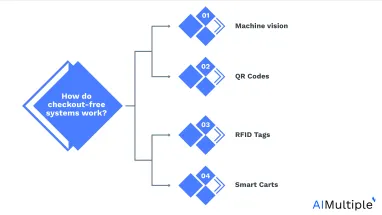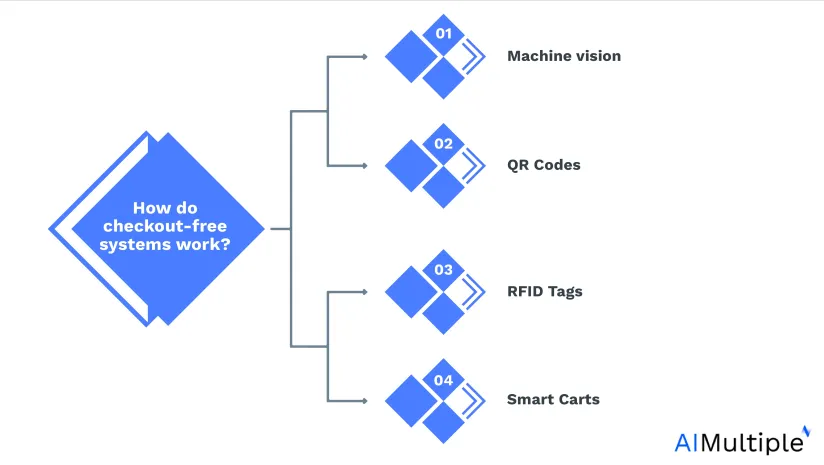An estimated 70% of U.S. shoppers are only willing to wait up to 15 minutes in a checkout line.1 To address this growing impatience, retailers are turning to computer vision and machine learning technologies to streamline traditional shopping experiences and reduce wait times at checkout.
Get a grasp of the checkout-free systems inside out:
What are check-out free systems?
Every day people complain about queueing while shopping offline. Technology players, like Amazon, combine computer vision, machine learning, and a plethora of sensors to deliver checkout-free stores.
Checkout free systems, also called cashierless checkout, are autonomous checkout systems that detect customers’ choice of products and bill them for these products at the end of their shopping experience. There are various solutions to determine and invoice the purchase, such as QR Codes, Smart Shopping Carts, RFID tags, and machine vision.

How do checkout free systems work?
Machine vision
The entire checkout is software-based. Cameras can capture individuals’ movements of picking up products from the shelves. Then, machine learning algorithms (e.g. image recognition) assign goods to shoppers accurately.
- The entire association is done through an app on the customer’s phone. When individuals arrive at the store, the app on the phone links them to the store and automatically initiates the shopping experience. Once customers are done, it sends the bill or performs immediate payment transactions.
- In this system, cameras are considered both functional and economical since they are already common for security reasons. In other words, security is guaranteed under a checkout-free system, optimizing the overall cost of the security and checkout system.
QR Codes
In this system, stores display the QR codes of the goods. Customers shop online first. When they decide on products, they click on the QR codes in store windows. Finally, they come to collect their order.
The applications of QR codes are already typical as it is easier for many stores to settle. Thus, the number of grocery stores with QR codes is increasing across the world. Specifically, after COVID-19, people tend to shop through QR codes due to health and safety reasons.
Customers also prefer the system since it decreases the time lost at cashier queues that are longer than average in many countries where COVID-19 restrictions were apparent.
RFID Tags
Radio-frequency identification (RIFD) is one of the technologies which emerged for military purposes and evolved into a commercial tool. RFID allows tracking and identifying physical objects. In recent decades, RFID gained importance in the retail industry.
By using radio waves, RFID tracks the product that was labeled before, then it transfers the data from the tags, which are small chips, to a reader. This data is stored, evaluated, and processed in an asset / inventory tracking system. Today, mobile devices or a handheld scanner serve as a reader. Once the customer’s bag is full, they complete shopping by paying on their mobile phones.
There are numerous types of RFID implementations. Retailers are recommended to decide based on the needs of their stores. They can arrange the scan distance, chip type, and frequency of these RFIDs. RFID systems are not solely advantageous to downsize the time at the checkout line. They also serve to ease the stock checks taking the time of workers and customers in many cases.
Smart Carts
Smart Cart program has been around for more than three years now. In this system, the stores have carts that are equipped with smart touchscreens.
While shopping, customers fill the cart. The camera at the cart’s screen will scan, weigh and link items. Finally, customers check out when the shopping is complete by paying directly to the cart’s card reader next to the screen.
Who are the technology players?
There are various checkout free stores, including big retailers like Amazon Go or Sam’s Club by Walmart as well as start-ups like Standard Cognition and Wheelys. There are also white-label solution providers that develop systems and implement them in a whitelabel manner in 3rd party stores. These technology providers usually benefit from most of the checkout free systems listed above.
These players develop various checkout systems based on smart phone apps or smart cards. Explore which checkout free systems these stores utilize:
| Store | Machine Vision | QR Codes | RFID Tags | Smart Carts |
|---|---|---|---|---|
| Amazon Go | ✅ | ✅ | ✅ | ❌ |
| ALDIgo | ✅ | ✅ | ❌ | ❌ |
| Carrefour Flash | ✅ | ✅ | ❌ | ❌ |
| Sam’s Club (Scan & Go) | ❌ | ❌ | ❌ | ✅ |
| 7-Eleven | ✅ | ✅ | ❌ | ❌ |
| Shufersal | ✅ | ✅ | ❌ | ❌ |
| SPAR | ✅ | ✅ | ❌ | ❌ |
| Standard Cognition | ✅ | ✅ | ❌ | ❌ |
| Wheelys 247 | ✅ | ✅ | ❌ | ❌ |
| Żabka Nano | ✅ | ✅ | ❌ | ❌ |
What are the benefits of checkout-free systems?
- Faster shopping process: Checkout free systems, as their name suggests, aims to reduce the period at the queues. The self-checkouts and scanning were developed for the same reasons. The technology in this field keeps expanding. You can find these technologies in the comprehensive guide about self-checkout systems. Yet, checkout free systems were reported as faster shopping processes. In a test session, they increased sales revenues by $37.7 billion.3
- They save financial resources and generate higher profits. For example, checkout-free stores do not need much personnel working as traditional cashiers and merchants. These people are reallocated or decreased in numbers.
- Additionally, most of these systems reduce the investment for security resources. Tracking systems or cameras linking items with individuals’ phones restrict shoplifting, which stores suffer the most.
- Use of extra space: Store owners can leverage the extra space that is created once checkout hardware and lines are removed.
- Data analytics: The tracked movement will create item and individual-level data, allowing retailers to reach robust empirics on item movement and purchasing behavior, and optimize inventory accordingly.
Other retail technologies
Retailer can benefit from numerous AI technologies today, such as:
- Retail chatbots are software applications conducting an online chat conversation via text or text-to-speech. They provide quick, personal and convenient support, 24/7 to customers.
- Other conversational AI applications in retail include voice assistants and personalized shopping experiences.
- Analytics are used to analyze all customer service activities, track key retail time monitoring KPIs of the retail audit checklist, and identify opportunities for reducing costs and improving service quality.
- Customer agents matches customers and agents according to the needs and required expertise.
- Biometrics allow customer authentication to improve customer satisfaction.
- Generative AI in retail helps develop personalize experiences, optimize marketing, and streamline operations.
- ChatGPT for customer service supports retailers by providing instant, accurate responses to customer inquiries, reducing agent workload, and improving response times across channels.
FAQs
What is check out free payment system?
A checkout-free payment system allows customers to shop without going through a traditional checkout process. Using technologies like sensors, cameras, and mobile apps, the system tracks items taken by the customer and charges their registered payment method automatically when they leave the store.
How does checkout-free work?
Checkout-free systems utilize a mix of AI, sensors, and cameras to identify products selected by customers. These items are automatically added to a virtual cart linked to the customer’s account, and payment is processed upon exiting the store, eliminating the need for a cashier.
What are self-checkout systems?
Self-checkout systems enable customers to scan, bag, and pay for items themselves without a cashier. Customers use kiosks or terminals to process their purchases, often with options for card or mobile payments, providing a faster and more independent shopping experience.
What is frictionless checkout?
Frictionless checkout refers to a seamless shopping experience where traditional bottlenecks like waiting in lines or scanning items are eliminated. Advanced technologies handle item tracking and payment automatically, allowing customers to shop and leave the store effortlessly.
Let us help you identify the best checkout free system:
External Links
- 1. Consumer Survey: The State of Waiting in Line (2022) | Waitwhile. Waitwhile
- 2. Offline shopping is about to be revolutionized by checkout-free technology – AI Retailer Systems.
- 3. http://files.constantcontact.com/30ddbc6b001/713f63a1-9353-4a51-97ad-1e4b0aa3af11.pdf



Comments
Your email address will not be published. All fields are required.